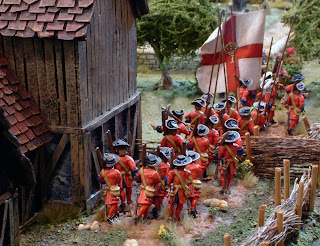 |
| The Coldstream Guards go to war |
For those with an eye for detail you may have picked up that
regiments listed in the battle summaries seem to change names. This is because
the numbering system came to the army much later than the period in question and
up till the mid- 18th century regiments were known by the name of
their colonels. These changed frequently with promotions, deaths, cashiering
and retirement! To get full wargaming value out of the units you may wish to
model I have noted the later number in the line if the regiment survived into
the period of that system of identification. Those regiments without numbers
were disbanded at some point after the period.
Weapons and changes
This was a time of significant transition in terms of
weaponry. At the beginning of the period regiments contained between 500 and
1,000 men in 13 companies. Each contained a mixture of musketeers and pikemen
in a ratio of between 3 and 5 to 1. This changed over time as the pike was
phased out although animated debate still rages over whether the British
carried pikes for at least some time during the War of the Spanish Succession
1701-1714. Musketeers began the period carry matchlock muskets and powder
bandoliers with apostles and finished by moving towards flintlock muskets and ammunition
pouches. British infantry fire tactics evolved to the so called platoon firing
system during the period after 1700.
Marching on
Following
the War of the Spanish Succession the tale of the Redcoat is signposted with
many highs and a few lows. Their reputation stands the test of time and history
is favourably disposed towards their performance which has lasted into the
khaki phase and on into the modern era. Their beginnings are a truly
fascinating and under explored phase worthy of interest and filled with gaming
opportunity. The infant’s survival was indeed a desperate struggle but he grew
into a man of distinction with a career packed full of stirring tales and
excitement to which pages continue to be added.
Red Coats
The red coat is synonymous with British infantry but usage
did not become universal till well into the period. As colonels had a lot to do
with the clothing and management of their regiments, coat colours varied widely
during the period 1670-1700. Many British regiments used red but the shade
would be variable. Highly unlikely would be bright scarlet as this shade was
too expensive to produce. Red varying from mid brown through brick, washed out
rose, ‘blusher’ red-pink to a deeper, darker red is far more likely. Officers
who could afford more expensive clothes may have a more recognisable
traditional mid to bright red. The British also used blue for a few regiments
including marines. Grey was relatively common particularly for newly recruited
units as it was cheap. This might be of varying shades. Regiments with Royal
connections wore cuffs, waistcoats and breeches in blue. Cuff colours were the
most obvious distinction between units of the same colour coat. Common were
yellow, greens, buff and red. Less common was black, orange-tawny, purple and
grey. Prominent amongst Scots regiments was white or off-white, few other
colours were used by them.

